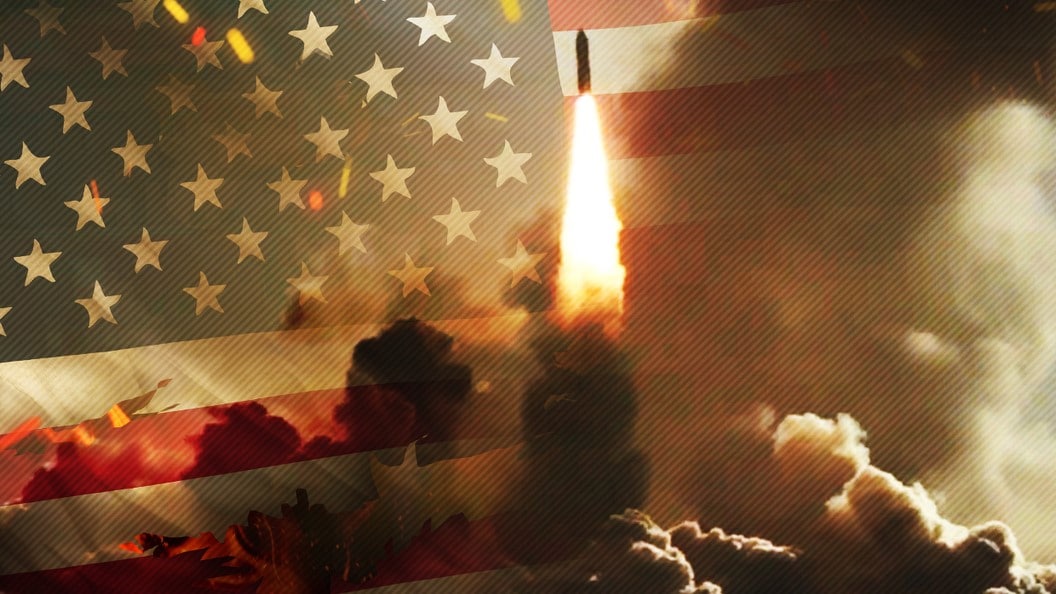On May 22, 2018, the Russian Navy launched a salvo of four Bulava intercontinental ballistic missiles from the nuclear powered submarine "Yuri Dolgoruky" at a test range in the White Sea from Kamchakta area to the Kura landfill.
As reported by the Russian media outlet Sputnik, the Bulava missiles "flew over 5,900 km over northern Russia before landing at the Kura Test Range in Kamchatka" in Russia's Far East.[1]
It is worth noting that the Bulava missile, designed for Russia's fleet of ballistic missile-carrying Borei-class nuclear submarines, can deliver up to 10 nuclear warheads at a range of 8,000 kilometers.[2]
Commenting on the test, retired Maj. Gen. Vladimir Dvorkin, the former director of the Russian Defense Ministry's missile and aerospace-focused 4th Central Research Institute, said: "On the issue of four missiles being launched at once, this is not exactly news. In their own time, salvo launches have involved the launch of up to 16 missiles, i.e., a sub's entire complement. But this launch was important for the Bulava, which previously faced difficulties in development." He then added that Bulava's development problems "are a thing of the past."[3]
The Russian Northern fleet's press-service reported that all the test assignments were fulfilled. The tactical, technical characteristics and reliability of the nuclear-powered ballistic missile submarine, Borei (also known as project 955) and of the Bulava missiles have been confirmed.
It is worth noting that the Borei, armed with Bulava ballistic missiles, is one of the primary components of the Russian nuclear triad. Specifically, the nuclear submarine K-535, - named Yuri Dolgoruky - is the lead ship of project 955. It has been part of the Northern fleet since 2013.[4]
Not coincidentally, that very year the Russian fleet adopted the R-30 sea-based intercontinental ballistic missile aka 'Bulava.' This is a three stage MIRV solid fuel rocket with six individual warheads equipped with their own guidance systems. The Borei missile system consists of 16 separate pieces. Thus, one vessel carries 96 special munitions, capable of destroying "enemy cities."[5]
The Russian Orthodox and strongly nationalist media outlet Tsagrad.tv reported that the U.S. should be concerned about Russia's military capabilities, since a first strike employing the Borei missile systems could destroy 130 American cities.
Below are excerpts from an article published by Tsagrad.tv:

(Source: Tsargrad.tv)
'Why In The World Are Those Even Needed? One Reason And One Reason Only – The United States. It Is To Be Considered A Kind Of Global Shark'
SUPPORT OUR WORK

"The Russian fleet currently holds three 'Borei' [missile systems]. Thus, in the event of an attack on Russia, the enemy is potentially deprived of 288 cities. Of course, not all warheads would hit in such a scenario. Additionally, the enemy would have reason to believe that not every such submarine would survive until it has to fulfill the order to carry out a retaliatory strike. However, even under such tolerances, it is clear that the recent calculations performed by Tsargrad [on the basis] of American analysts that Russia could destroy 130 American cities on a first strike seems wildly optimistic.
"Moreover, two additional operative factors work to force Americans into pessimism. First of all, five more new underwater cruisers are being produced in the modernization project 'Borei-A.' According to plans, 14 units should be transferred to the fleet. Secondly, 'Borei' has equally fearsome 'friends' — the submarine missile carrier project 'Ash.' And thirdly, the R-30 missile, which has made very dramatic progress since the design stage, is by itself capable of overcoming the American missile defense systems.
"Fourth generation ballistic missiles for nuclear submarines of the fourth generation appeared in the form of outlines on [military] drafting boards (well, conditionally, of course, where they are invented, the projects start somewhat differently) in the late 1980s. At first they were assigned to the Miass KB machine building factory. Currently that task is handled by the Makeev Rocket Design Bureau.
"There they began to build the liquid-propellant three-stage rocket 'R-39UTTH,' which was called 'Bark'. While the project was being designed and created the 90's began. At that time, [Anatoly] Chubais [An influential Russian-Soviet politician responsible for privatization) and [Yeltsin's deputy prime minister Alfred] Koch faced real opponents from the [Communist Party appointed] 'Red Directors' in the military industrial complex, that did not allow the dismantlement of similar factories as opposed to more 'civilian' production'...
However, for them as well, to employ the language of biology, the 'food supply' was cut severely. Rocket production in Miass fell off greatly.. .
"However, as in other places. This meant that competition had greatly intensified. Competition escalated everywhere. The 'Sukhoi' company tried to swallow up 'MIG.' At the first failure of 'Bark' it was concluded that the weight of the device was higher than requested in the technical specifications and the first launches were unsuccessful and the submarine project for this rocket had to be redesigned. The government commission decided that this was reason enough to shut down the project, because someone had come up with the bright idea; simply modify the marine version of the already well tested Topol ground missile.' The creation of this project was entrusted in 1998 to the Moscow Institute of Heat engineering. And those who know, remember that in the 1990s the former Scientific Research Institute (NII 1) of the Ministry of Agriculture was not... well, to put it mildly, not anything to boast about.
"So it can be said that the creation of 'Bulava' was a painful bloody business. Money was fanatically stinted by refusing unnecessary testing; timetables were shifted. Finally, by 2007 the missile was ready to go into service. It however then went and failed six consecutive tests. The causes of failure for each incident were different. This lead to a frenzy among designers, defense officials, and the military who eventually concluded that it was not the actual design of the system which was defective. But rather, it was the chain of production itself.
"Meanwhile, since 2006, Russia had been acting to secretly modernize and rearm its military force. With the consecutive failures of 'Bulava' they literally wanted to spank someon while pointing to many the dire consequences of theft, sloppiness, and violations of production and technological discipline.
"Soon afterward, the Bulava project was mated to the cruiser 'Yuri Dolgoruky', which became the first reliable 'testing ground' for the missile. The first salvo– at that time two more rockets -- were made in 2011 and in January of 2013. Bulava was adopted into service simultaneously with the raising of the Andreevsky flag on 'Yury Dolgoruky.'
"The tests continued -- but not always successfully: of the 26 launches in 12 years, only 14 were recognized as fully successful. However, the trend was, as they say, positive.
"In this light it is clear that the simultaneous volley of four missiles fits well into the ongoing test program. But at the same time the missile 'Bulava' is in service! And it is able to throw more than a ton of useful (not for the enemy, though) weight at a distance of 10 thousand kilometers. Moreover, the range of circular error probability (CEP) will total 120 to 350 meters. However, it should be noted that the test firing of the entire silo of missiles is in generally seldom practiced. Civilians know this is bad. However, the launch of ballistic missiles by underwater submarine cruisers is a major challenge in itself and certainly a salvo.
"The full volley of missiles should only be fired in one situation – when the cruiser receives the most important command. After that, almost everything becomes unimportant, including the technical condition of the ship after such an effort. And today it was verified that 'Dolgoruky' contains four rocket salvos.
"Why in the world are those even needed? One reason and one reason only – The United States. It is a kind of global shark. Always on the prowl– ready to tear off its slice. Which today is clearly and demonstratively refusing to comply not only with international rules and regulations, but also agreements signed by its own rulers. They beat [other countries] with sanctions and stun them with ultimatums.
"But in reality this so-called 'Shark' is afraid of hard geopolitical responses to its actions. For in its 250 years of history, the USA has arranged more wars, than in Europe's two thousand years of spectacularly bloody history. Yet, during all this time the U.S. has never really engaged in battle with another strong opponent. It was a shocking moment then for the U.S. Administration when it found itself (after painting itself immortal by its great military feats) face-to-face with a foe with fangs – necessitating a fight forged by iron and blood rather than with shark-like hit and run tactics. Suffice it to say the Americans remember their four years of struggle with the Japanese quite seriously, [the same Japanese] whom the Russian army defeated in a week in 1945.
"So it is quite obvious who the intended recipient of the message sent by the testing of the four-missile launch from the Yuri Dolgoruky cruiser is. Precise messages, because it is understood that the system which is being tested will serve on behalf of those who ordered it – the Russian military. If the wrong choice is made [by the U.S.] in its future relations with Russia, 288 potential cities will die and not on the Kamchatka testing range but actually in the U.S. – this is the message. Let us hope that they will understand."




